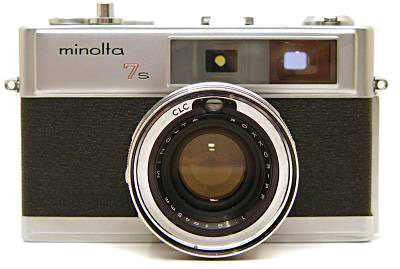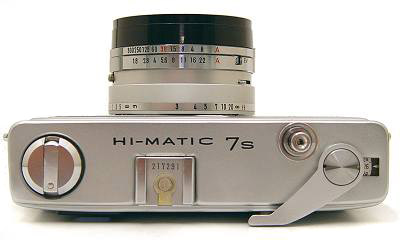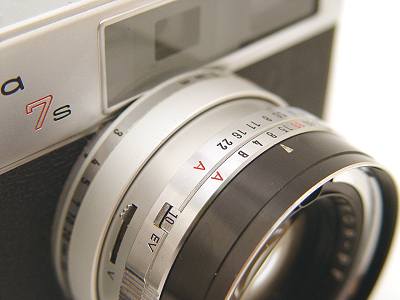|
Minolta produced numerous rangefinder cameras (see e.g. this link). The most popular models are found in the Hi-Matic series, which was started in the 1962 with the Hi-Matic and continued until the 1980s, the Hi-Matic 7sII being the latest and most advanced model. The Hi-Matic 7s was released in 1966 as a direct sucessor of the Hi-Matic 7 and providing some improvements with respect to the latter. It is a typical 1960's camera considering its size, which compares well to e.g. the Konica Auto S2 and the Yashica Electro 35. The camera is very well made and certainly underrated. The lens is a sharp Rokkor f/1.8 45 mm. The viewfinder is very bright and shows a clear diamond-shaped split image distance meter. The viewfinder-frameline positions are parallax corrected. The Hi-Matic 7s has a program oriented automatic mode which can be manually overridden. On the lens barrrel there is a ring for the selection of the exposure time and the aperture. If the "A" marks on both rings are moved to the central arrow the camera operates in a fully automatic mode. If both "A" marks are moved away from the arrow, the camera operates in manual mode with the time and aperture values selected. Although it is possible to put only one of the rings into "A" position, it is not possible to use the camera in semi-automatic aperture- or exposure time-priority mode. A unique and very useful feature of the 7s is that the exposure meter is active during manual operation. It don't know why, but in most other 60's and 70's rangefinders except for the Olympus SP the meter is disengaged in manual mode. The camera is essentially EV oriented - in the viewfinder the results of the light meter are shown in terms of EV values and on the lens barrel a small window shows the EV value corresponding to the actual exposure time/aperture combination for the chosen film speed. The Hi-Matic 7s, als well als the Hi-Matic 11 and 9, have a rather peculiar rangefinder system. Other than in most other cameras, turning of the focusing wheel leads to a shift of the main image in the finder while the the secondary-image patch remains fixed. The focusing mechanism in this camera works via a horizontal tilt of the front lens of the finder system. This is rather surprising in practice at the beginning, but works as well as the usual shifting secondary image. The Hi-Matic 7s takes one PX625 1.35V mercury battery. The battery is required for the meter and the camera will manually operate without it. The PX625 type of battery is discontinued. It can can be replaced with the equally sized PX625A Alkali battery, which, however, provides a voltage of 1.5 V. Consequences for the meter reading have, at least for fresh batteries, to be accounted for. The Hi-Matic 7s has an undocumented feature which is not even mentioned in the manual: The ASA switch also serves as on/off switch for the light meter. Another useful (and distinguishing) quirk. |
|




